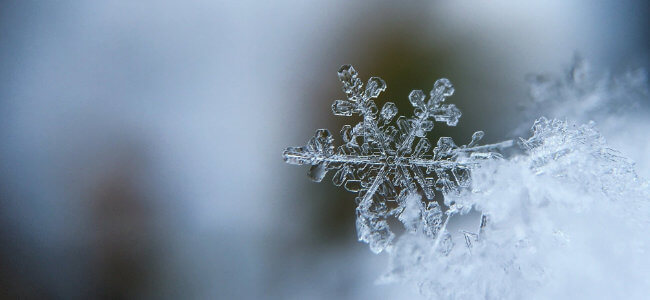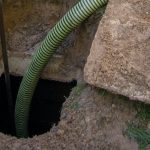Ahh, winter. The frigid, dark, hibernating by the fire time of year. Bah-Humbug. 😉 Nevertheless, it’s upon us again, and we’d like to answer a question that may be ruminating in any new-to-septic or snowbird’s mind: Is it possible for your septic system to freeze?
Answer: Yes, it is possible for your septic tank, sewer pipe, or drain field lines to freeze. This is dependent on several factors: water usage in your household, pitch of piping, depth of piping, depth of frost, and whether you regularly maintenance your system.
Your piping is more likely to freeze than your septic tank because the sewage in your tank generally stays between 50°F and 60°F, even in the winter months. This is due to the addition of warm water from the household and heating within the structure and plumbing system. There are also bacteria in your septic tank that generate heat. Solids enter the tank and eventually settle to the bottom, creating a sludge where heat-generating bacteria thrive. Most the time, this is enough to prevent your tank from freezing, depending on length of time with no water usage and assuming there are no other contributing factors. For instance, if it’s a seasonal cabin or unoccupied rental, the chances of your tank freezing increases. This is because your tank cannot maintain sufficient temperatures to avoid freezing with the absence of warm water and sewage entering the tank.
ZSU Recommendations
No matter what type of property dwelling or septic system, maintain a service agreement with a licensed septic professional! In general, have your tank cleaned out every 2-3 years with a conventional system and every other year with an aerobic or NSF40 unit. Keeping a service agreement with a septic company allows you to catch a problem before winter hits and repairs become difficult and expensive. For seasonal homes with an aerobic treatment unit, the blower or aerator should be shut off if no one will be using the system. You may also want to consider pumping the tank before you leave for the winter. Only do so if the tank was designed and installed for high- water table conditions. This area of IL has a high-water table and completely pumping the tank could cause the tank to float out of the ground (even concrete tanks-we’ve seen it!). The best course of action in this situation would be to have someone use warm water in the home regularly. Overall, regular use and warmer water temperatures are important during particularly cold months.
More on sludge
If you don’t maintain your septic system with regularly scheduled tank cleanings, your tank has likely developed a thick layer of sludge. This could cause a backup into the main line and if the contents freeze, the pipe can burst. If anyone is home, they’ll realize there is an issue when the toilets don’t flush or water in the house isn’t draining. Your outlet and drain field piping could be at risk too. For pressurized systems, Zeiter’s always installs pressure pipe below the frost line to prevent this from happening. For gravity systems, David Zeiter, Owner/President, has a saying: “As long as there is proper pitch on a pipe, you can install it in the Arctic, and it won’t freeze.” Sure, there are exceptions to the rule, but the idea is that if you have proper pitch on a pipe allowing effluent to drain back to either the tank or the drain field, there shouldn’t be any water sitting in the pipe for it to freeze. One exception to the rule would be bellies or sags developing inside pipes over time, causing water to sit and freeze in the winter months. This is yet another reason to have your system serviced regularly as technicians are trained on how to detect potential problems.
ZSU recommendations
Check all plumbing fixtures for leaks or drips. Small trickles freeze easily within the pipes and can cause a pipe to freeze solid. Sara Heger, Ph.D., the education chair of Minnesota’s OWA and NOWRA recommends several winterizing tasks for snowbirds on septic. If leaving for an extended period, drain the system by opening all faucets and leave them open; completely drain the pressure tank. Check any flexible hoses in showers and sinks to ensure they are drained completely. Remove and drain hoses for the washing machine and dishwasher. Clear the water valve by starting the machine for a few seconds, then drain the tub. Remove the drain hoses and drain completely. Disconnect the electrical supply to the pump, water softener, water heater, washing machine, and dishwasher. Drain the water softener and water heater with a hose after power has been disconnected. In the spring, reconnect all hoses and flush the lines before using again. If you return home before temps in the soil begin to rise, the effluent exiting the tank will be cold. Pumping the tank and starting with fresh warm effluent is desirable for the soil treatment area (Heger, 2018).
Lastly, let’s discuss how to protect your drain field. Snow, if not compacted, can actually insulate your drain field, and help prevent freezing. Remember to keep all vehicle traffic off the septic system. This can cause compaction and push the frost further into the soil thereby decreasing the soils perc rate. Snow should not be plowed off the area or piled over the system. When the snow melts, it will add unnecessary water to your system and could flood it out causing backups in the home. All things considered, the best way to care for your system in any season is by calling a professional at the first sign of a problem. Have your system serviced based on the manufacturer’s or septic company’s recommendations throughout the year. Remember, ZSU is in office all year long should you find yourself in an emergency and our trained professionals know how to diagnose and help you fix the problem.
Heger, Sara. “Preparing Seasonal Septic Systems for Winter.” Onsite Installer, 5 Apr. 2019, https://www.onsiteinstaller.com/online_exclusives/2018/10/preparing-seasonal-septic-systems-for-winter.
[/vc_column_text][/vc_column][/vc_row]




